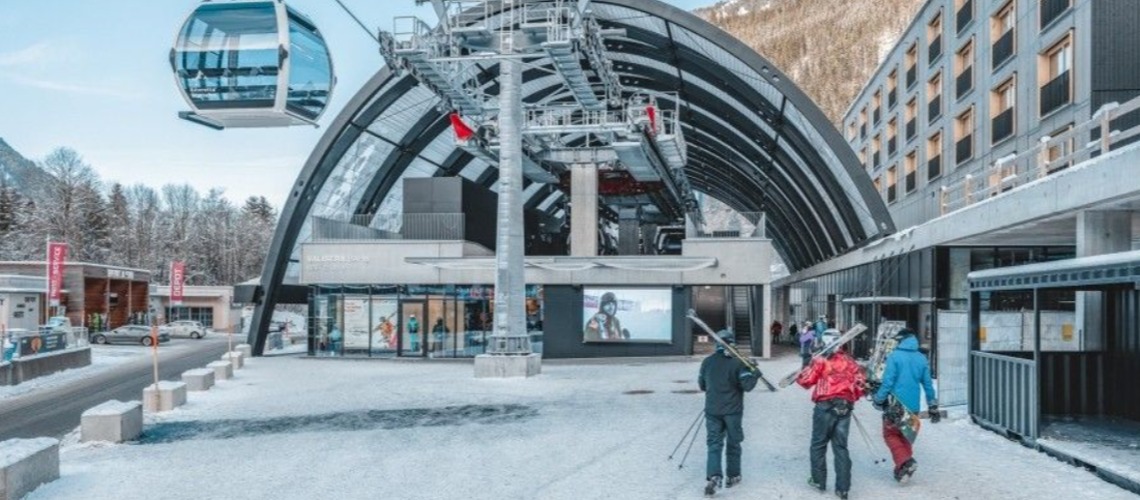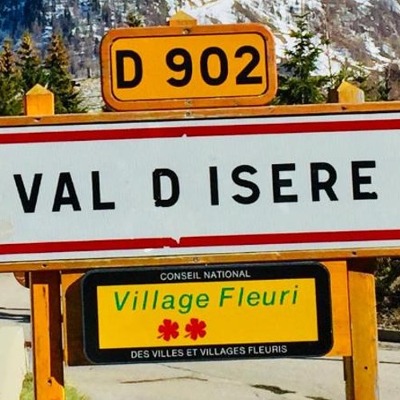Salzmann Engineers Complete Valisera Bahn St. Gallenkirch

For 40 years, the old Valisera Bahn with its 6-seater gondolas connected the two parts of the Nova ski area in St. Gallenkirch and Hochjoch in Schruns in the Vorarlberg Montafon. Since the winter of 2021/22, the high-performance system, which was also unique at the time it was built in 1981, has found a worthy successor in Austria's first autonomous 10-seater gondola lift. The replacement was implemented in just a few months on the basis of the existing route and station locations - despite significantly expanded dimensions, traffic optimization and new cable car technology worldwide.
The Vorarlberg tourism destination Silvretta Montafon has been combining the two ski areas Nova and Hochjoch since 2008 and is one of Austria's largest ski areas with more than 140 kilometers of slopes and 35 lifts. The merger was also practically sealed in 2011 with the construction of the Grasjoch Bahn in the district of Galgenul near St. Gallenkirch. Right across from the new 8-seater gondola lift (Newsletter No. 5) built by Salzmann Ingenieure, the Valisera Bahn, built in 1981, took its guests up to the Nova region at more than 2000 meters above sea level.
The first considerations for a modern new building for the veteran 6-seater gondola lift were made back in 2008. Seven years later, plans were rolled out with an alternative route and an inclined lift into the Vermiel valley. When the complex project failed, Salzmann engineers took over the planning of a 10-seater gondola lift based on the existing route and stations in 2017.
In addition to the increase in capacity from 2,200 to currently 2,800 and up to 3,600 people per hour in the final phase, the new Valisera Bahn, Austria's first autonomous cable car, is setting new trends worldwide. This also applies to the valley station, which was designed as a multifunctional center: The Silvretta Park Montafon houses a sports shop, ski school, market hall, staff rooms and a hotel complex with more than 100 rooms, restaurant and bar. There is also an underground car park with 50 e-charging stations and a total of 600 parking spaces . As with the Grasjoch Bahn, the Innsbruck office of Obermoser + Partner Architekten was responsible for this terminal with its spectacular foil screen. The middle and mountain stations, designed by Salzmann engineers and Lang Vonier architects, are at least as impressive.
After a proud 40 years of operation, the first excavators rolled up in April 2021: demolition, construction and conversion began. The entire cableway with new supports and stations was completed in mid-December in a record-breaking eight and a half months - despite the pandemic and within budget. Punctually at the start of the 2021/2022 winter season, the first guests boarded themselves without any supervision and 14 minutes later at a dizzy 2108 meters above sea level - an unforgettable experience.
With a total investment volume of 70 million euros, the new construction of the Valisera lift, together with the construction of the Silvretta Park, is one of the largest construction projects in Vorarlberg's winter sports history and was also the largest state-wide construction project in 2021. About one third of the costs were for the innovative ropeway technology. From a legal point of view, the new construction is a rebuild. Since the positions of the ropeway and the stations were not changed, only an extension of the existing concession was required. "The valid contracts ultimately created the basis for a timely realization before the end of the concession. By keeping the line layout unchanged, we were able to integrate the two basement levels of the top station into a rebuild concept, thus saving money and resources," reports planner Stephan Salzmann.
The results are impressive: The Valisera Bahn is not only the first autonomous cable car in Austria, but also the first two-section cable car of its kind in the world. The technical basis for the innovative transport system is the AURO system (AUtonomous Ropeway Operation). the house of Doppelmayr. “Our guests are already experiencing the future of international ropeway technology in the new Valisera Bahn. The state-of-the-art facility guarantees quick and smooth transport, ensures the highest level of service and comfort, blends harmoniously into the mountain landscape and also impresses with its sustainable and aesthetic design," emphasizes Martin Oberhammer, Managing Director of Silvretta Montafon Holding.
The heart of the Valisera Bahn is located at 1,630 meters: the middle station, with the so-called Ropeway Operation Center (ROC), is the control center for the entire cable car. In the command and service room, one person is responsible for mountain and valley operations. In the valley and mountain station, the passengers act independently and yet always in the view of the professionals. Numerous cameras and sensors provide information about the situation in the unmanned stations.
When implementing the innovative system, the planning team headed by Stephan Salzmann also had to solve fire protection and safety aspects. “The autonomous operation required an additional control system and special building technology. This allows elevators or escalators to be controlled externally in emergency situations and entrance gates to be closed remotely,” he explains. Only in the event of a malfunction do the operating personnel have to step in at the unmanned stations.
In addition to the command center, the completely redesigned middle station also houses the drive for both cable car sections and the large cabin station. It offers space for up to 170 cabins on more than 2500 square meters.
The most visually striking measure is certainly the wide slope loop on the roof of the station. It enables comfortable entry as a repeater back up the mountain, direct access to the children's area and the ride down to the valley with the cabin. "We had to place the cable guide one floor below the platform level of the existing railway and embed it in the mountain. This is how a funnel shaped exit towards the mountain. In summer, the platform blends harmoniously into the landscape as a green roof,” reports Salzmann. While he and his team took on the overall planning of the building, Lang Vonier Architects from Schruns contributed to the architectural design of the station.
Ten people instead of six, indoor ski holders via the TWIST-IN system, heated seats and 40 years of progress: In order to bring the much higher and wider cabins onto the specified track without additional forest clearing, Salzmann used very high cable guides for the first supports. “An average house fits on the foundations of some supports. We're moving above the trees here," says the planner.
The journey in the spacious cabins ends at 2108 meters above sea level with the agony of choosing the slopes. With the all-round redesign of the mountain station, Salzmann Ingenieure created an optimal starting point for the guests in cooperation with Lang Vonier Architects. A new mezzanine bridges the distance to the ideal exit point right at the level of the plateau between Valisera Hüsli and Bella Nova. Seven meters were increased for this.
Productive sun games and optimal recycling
Today, a light-flooded hall awaits passengers when they arrive at the top. Circumferential photovoltaic panels are responsible for the impressive play of light and shadow. These also provide clean electricity for operations where the sun shines most of the time. "In terms of technology, architecture, organization and energy, the Valisera Bahn is an absolute showcase project - and every journey is a very special experience," says Martin Oberhammer happily.
While the old intermediate station was completely demolished and rebuilt in the same position, the new mountain station stands exactly on the walls of its predecessor. "We wanted to recycle as much as possible, and a sensible subsequent use was also found for the steel structure of the former platform hall," says Salzmann. Since then, the old structure has been used with a new wooden facade as a warehouse for torrent and avalanche control.














